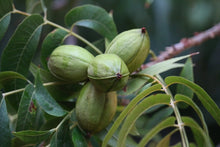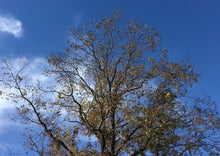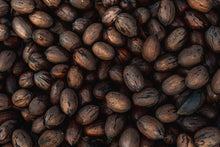|
Mature height x width: |
approx 80-100' x 50' |
|
Recommended initial spacing: |
5'-10' in rows 25' apart (to be thinned later) |
|
Recommended final spacing: |
25' (intermediate) 50-60' (final) |
| Hardy to: | approx -20°C |
|
Preferred soil: |
rich, moist, well-draining soils. Tolerates clay but not sustained wet feet. |
|
Good for: |
ornamental, tall, upright |
|
Uses: |
dessert, main dish |
'Mid' ultra-northern ripens earlier in the fall (approx mid-late Oct) with smaller nuts than 'Late'. While pecans are native to the Mississippi valley in the southern US, this ultra-hardy pecan has been developed by pecan enthusiasts John Gordon and Gary Fernald, among others. Pecans require hot days and warm nights in order to ripen, so these intrepid nut tree breeders sought out pecans at the very northern tip of their range, and selected for the earliest-ripening "ultra-northern" pecans. These nuts will be smaller than southern cultivars, and you'll need to be patient: pecan seedlings will begin bearing somewhere between 5 and 15 years.
Planting: pecans want rich, moist, fertile, soil (think valley bottom). A great choice for the edge of marshes or riparian zones, as long as the soil is still well-drained. Plan in full sun for best production.
Why seedlings? Growing seedlings from productive, vigorous parents helps maintain diversity (each seed is a new variety) while drawing on some of the best genetics available. In other words, by planting seedlings, you are participating in the breeding and selection of new, regionally-adapted varieties.
Why potted? If you won't be planting your trees right away and you don't feel sure about storing bare root trees then you want potted trees. Potted trees will allow you more flexibility with transplanting timelines and late spring installations, however, they are more expensive to produce and to ship.
Our nuts are grown in tree pots, which are designed with a large opening at the bottom to air prune the root. When the taproot reaches the bottom, instead of circling around, the opening enables the root to gently 'self-prune' itself, stimulating the growth of feeder roots further up.





